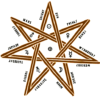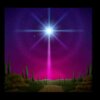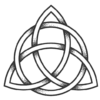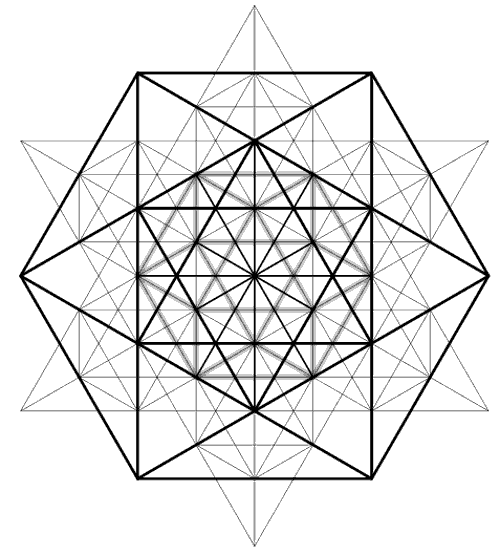
Since ancient times, various geometric shapes, patterns, and proportions have been deemed sacred, thought to hold the secrets of the universe within them. These symbols collectively form what is known as sacred geometry. In this article, let’s explore 18 of the most powerful sacred geometry symbols and delve into their hidden meanings.
So let’s begin.
23 Powerful Sacred Geometry Symbols & Their Symbolism
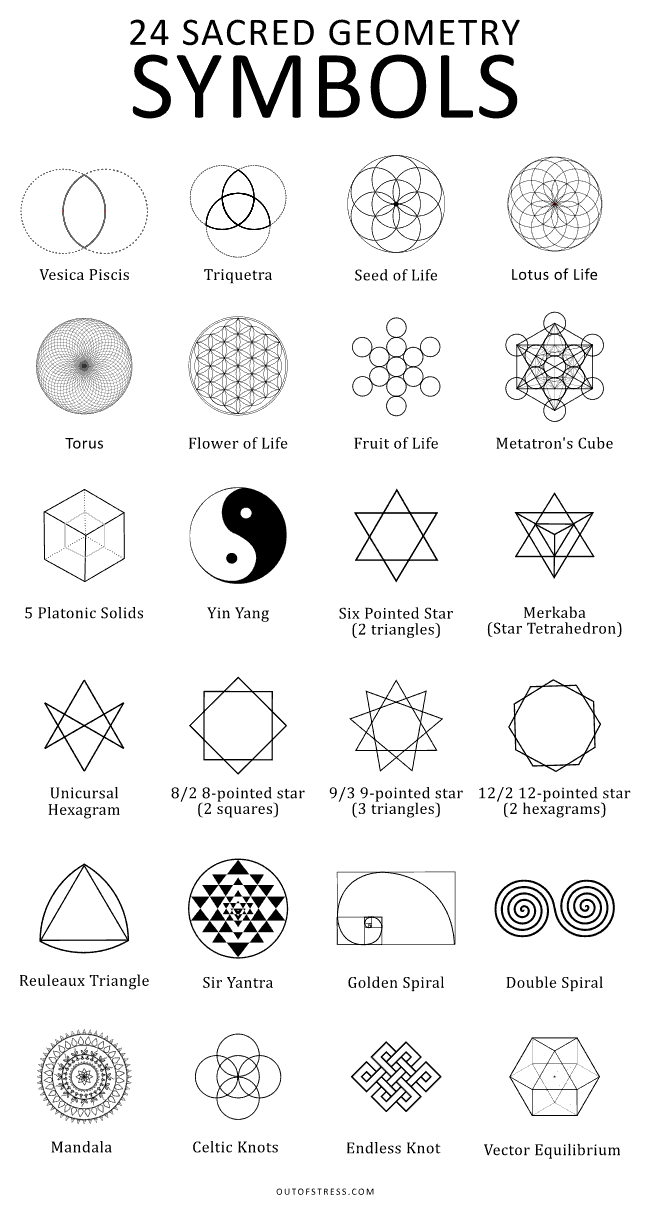
1. Dot & the Circle

In sacred geometry all basic shapes including the dot, circle, triangle, and square have sacred meanings. The dot which is perhaps the simplest of all forms represents the one god, one source or consciousness.
Similarly, the circle which can be seen as an expansion of the dot represents the expansion of consciousness or God’s mind. What’s special about the circle is that every point on the circle is equidistant from the central dot. Similarly, the circle does not have a beginning or end and maintains its shape irrespective of how you rotate it. Thus the circle represents infinity, feminine energy, fluidity, oneness, and the cyclic nature of the universe.
When we intersect a circle with another circle, we get a popular sacred geometrical form known as the – Vesica Piscis. Let’s discuss that in the next point.
2. Vesica Piscis
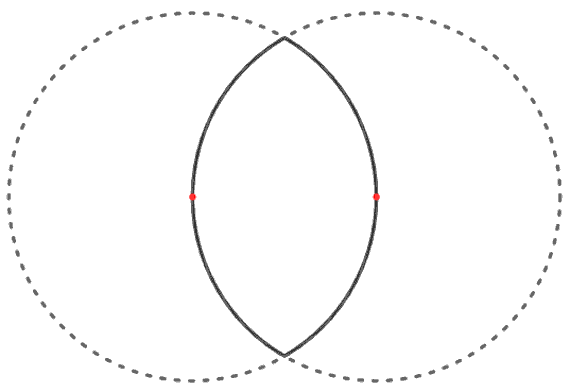
The Vesica Piscis is one of the most basic yet powerful symbols in sacred geometry. It is composed of two intersecting circles, arranged so that the edge of each circle passes through the center of the other. The lens-like shape created by their intersection is known as the Vesica Piscis or Mandorla. It primarily represents creation. Here’s why.
One circle of the Vesica Pisics represents the spiritual realm whereas the other represents the material realm. Hence, lens-like shape created by their interaction denotes the sacred portal of creation or the Cosmic Womb.
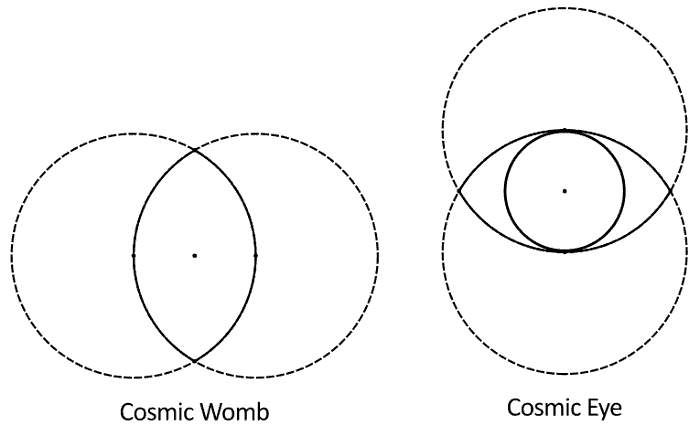
As shown in the image above, when viewed horizontally (with the circles side by side), the Vesica Piscis symbolizes the Cosmic Womb from where creation emanates. When viewed vertically (with one circle atop the other), it represents the Cosmic Eye or the All Seeing Eye of God or Source.
The Vesica Piscis also contains within it many other important sacred geometry symbols, some of which are as follows:
- Equilateral triangle
- Diamond or Rhombus
- The cross
- Jesus Fish
- Five-Pointed Star (Pentagram)
- Six-Pointed Star (Hexagram)
The following image illustrates some sacred symbols found within the Vesica Piscis:
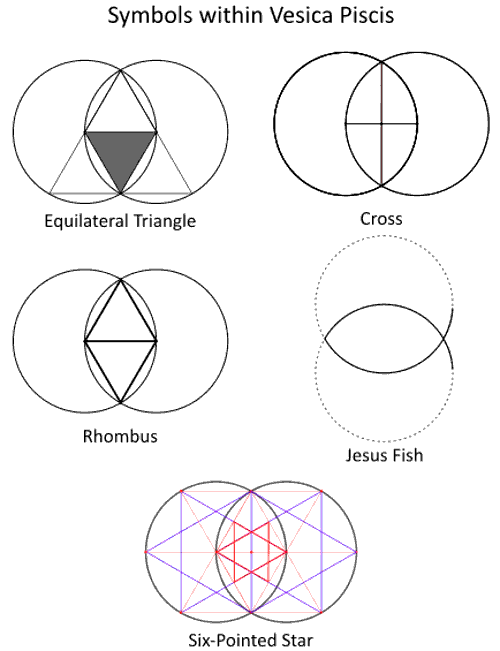
Expanding on the Vesica Piscis by adding more circles gives rise to even more sacred symbols like the Triquetra, Seed of Life, Flower of Life, Fruit of Life, Metatron’s Cube, and even the Platonic Solids which are considered the building blocks of our physical reality.
3. The Triquetra
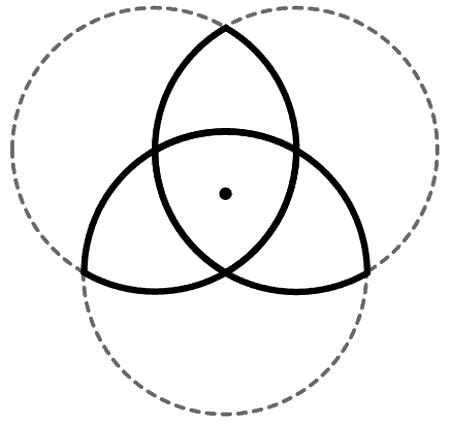
Expanding the Vesica Piscis by adding another circle creates the Triquetra. This is an ancient symbol that symbolizes the threefold nature of the divine. The three vertices of the Triquetra represent all the important triads of existence, some of which are as follows:
- Holy Trinity – Father, Son, and Holy Ghost
- Mind, Body, and Spirit
- Past, Present, and Future
- Creation, Preservation, and Destruction
- Positive, Negative, and Neutral
- Etc.
The Triquetra also contains within it a larger equilateral triangle that points upwards representing masculine energy and a smaller equilateral triangle that points downward representing feminine energy as shown in the image below.
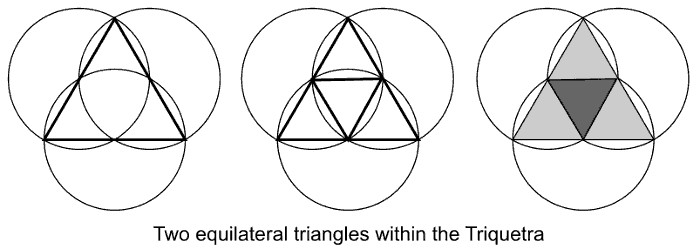
By inverting the Triquetra we get the larger triangle facing downward representing feminine energy and the smaller triangle facing upward representing masculine energy. Combining both these triquetras gives rise to the six-pointed star as shown in the image below.
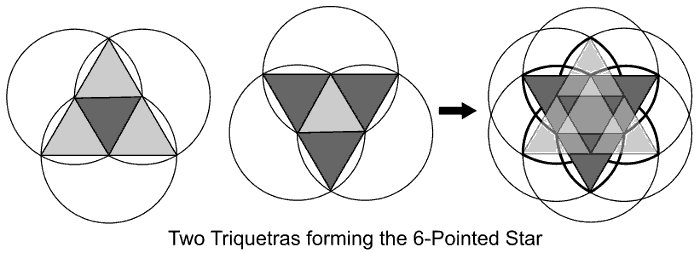
As you can see in the image above, the larger star and the smaller star within represent the concept of Yin-Yang – with the masculine present within the feminine and the feminine within the masculine. Hence this is the perfect symbol of balance and harmony.
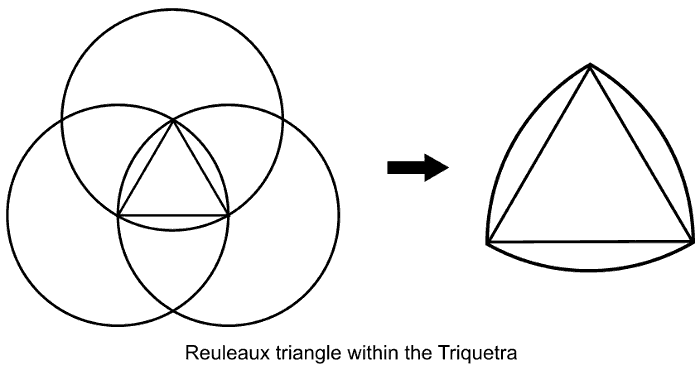
The Triquetra also contains within it the Reuleaux triangle. The Reuleaux triangle is unique because despite its curved sides it has constant width. This means, when rotated inside a square, it touches all four sides of the square at all times, just like a circle. Additionally, each point on the curve is equidistant from the opposite vertex.
4. Seed of Life
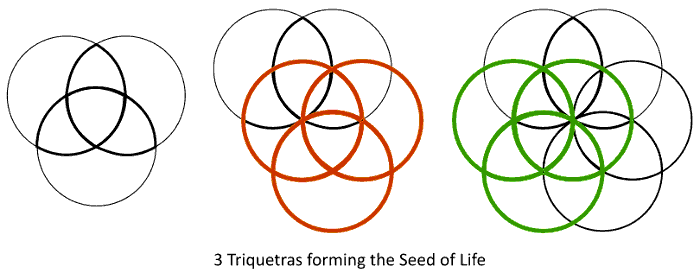
When three triquetras overlap, they form the Seed of Life (as shown in the image above). This is a pattern comprising seven circles: one at the center and six surrounding it.
The Seed of Life symbolizes the Christian seven days of creation, with the central circle representing the 7th day, or the day of rest (when God rested). This way, the central circle also represents source energy. Each of the surrounding circles connects to the center, illustrating unity, balance, and interconnectedness.
The Seed of Life contains numerous other sacred geometry symbols within, such as the Six-Pointed Star, 9-Pointed Star, 12-Pointed Star, Yin Yang, Infinity symbol, and the Hexafoil (Germ of Life).
Similar, by adding more circles to the Seed of Life, you can create many more sacred geometry symbols like the Flower of Life, the Egg of Life, the Lotus of Life, the Fruit of Life, and Metatron’s Cube and the Platonic Solids.
5. Lotus of Life
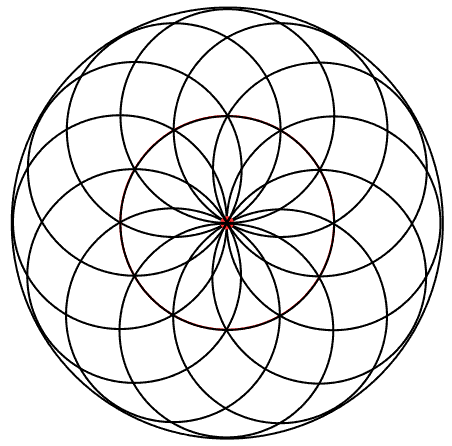
When you overlay two Seed of Life patterns and rotate the top one by 30 degrees, you create a 12-sphere pattern known as the Lotus of Life. This pattern symbolizes unity, balance, interconnection, prosperity, and eternity. When viewed in three dimensions, it resembles a tube torus.
6. The Torus
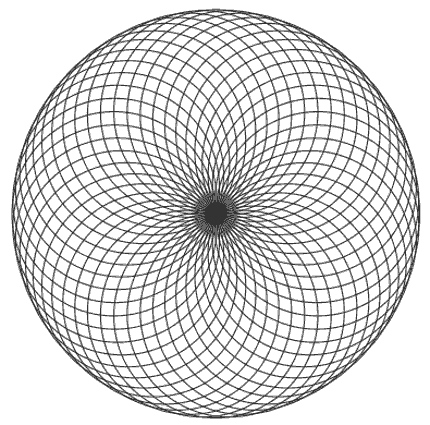
Another remarkable sacred geometry figure derived from the Seed of Life is the Torus. This shape is formed when you overlay 8 Seed of Life patterns and rotate each by a small degree. This is as shown in the video below:
The Torus is the fundamental shape emitted by all electromagnetic fields. Whether it’s the electromagnetic field of the heart, the energy surrounding atoms, or the human aura, they all share toroidal characteristics. Some theories even suggest that Earth is at the core of an expansive, torus-shaped electromagnetic field.
The torus symbolizes wholeness, interconnectedness, life cycles, and infinity.
7. Egg of Life
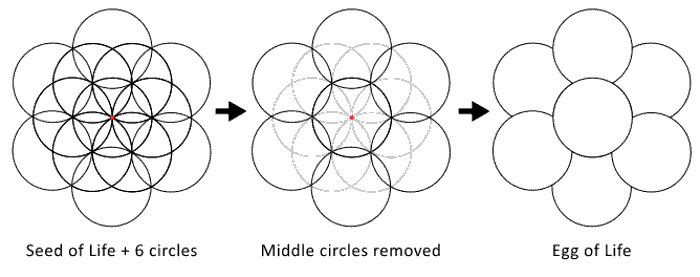
When you expand the Seed of Life by adding six more circles, remove the initial six middle circles, and envision the remaining circles as 3D spheres, you arrive at the Egg of Life symbol. This symbol features eight spheres—(six surrounding spheres, with one on top and one at the bottom), and can be considered the 3D version of the Seed of Life.
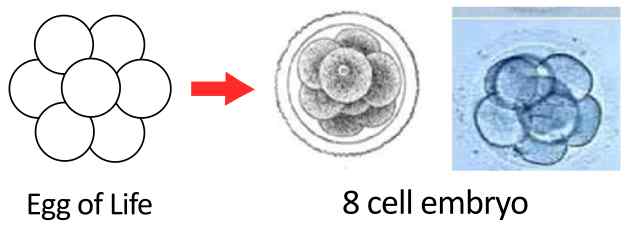
Interestingly, the Egg of Life closely resembles the structure of a multicellular embryo in its earliest stages of development (as shown in the image above). This makes it a potent symbol of creation.
Just as the Seed of Life incorporates the Six-Pointed Star, the Egg of Life includes the Merkabah, which is the 3D version of the Six-Pointed Star. Hence it also represents balance, unity, and interconnection.
8. Flower of Life
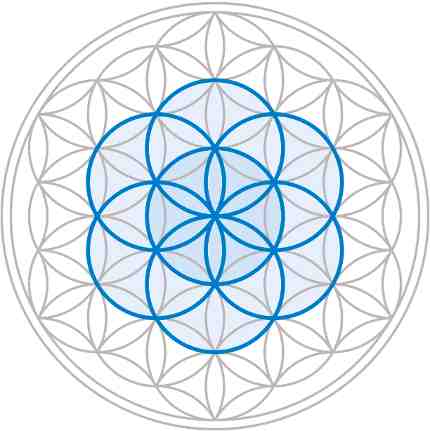
By expanding the Seed of Life by adding 12 more circles, you create the Flower of Life symbol. This symbol represents unity, balance, creation, and interconnectedness of all life to the divine source.
The Flower of Life is considered to contain the blueprint of the universe including designs of atomic and electrical structures, life forms, and all that exists.
The Flower of Life contains within it various other sacred geometry symbols like the Six-Pointed Star, 7 Chakras, the Kabbalistic Tree of Life, and the Runes. Also, by adding more circles to the Flower of Life, you can many other Sacred Geometry symbols like the Fruit of Life, Metatron’s Cube, and the Platonic Solids.
9. Fruit of Life & the Metatron’s Cube
When we add a set of 18 more circles followed by 24 more circles to the Flower of Life, we get an interlocking form consisting of 61 circles (60 circles surrounding the one circle in the middle). When we take the circle in the middle and highlight the 12 surrounding circles (so it forms an hexagonal shape) we get the Fruit of Life pattern.
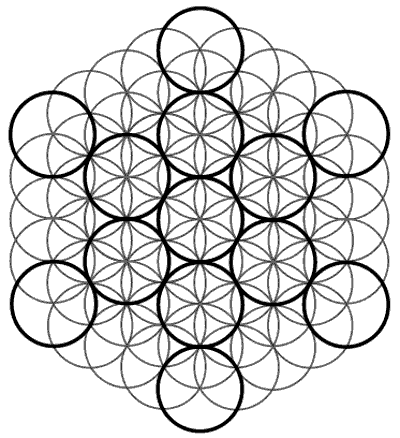
The circles in the Fruit of Life represent the Divine Feminine. When we connect the centers of all circles (with each other) using straight lines (which adds up to 78 in total), we end up creating a pattern known as the Metatron’s Cube (as shown in the image below).
The 78 straight lines represent the Divine Masculine and the circles represent the Divine Feminine. Hence the Metatron’s Cube represents the union of the Divine Masculine and Divine Feminine which is the basis of all creation.
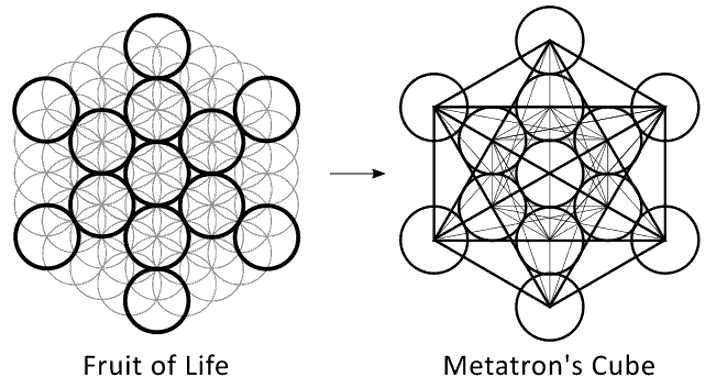
What’s unique about the Metatron’s Cube is that it houses within it all five platonic solids that are known to be the building blocks of the universe. (as shown in the image below)
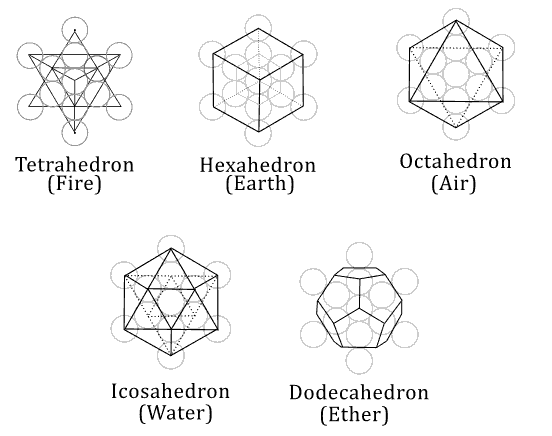
The Platonic Solids, and their various combinations, are believed to encompass all the geometric laws that define the physical world we inhabit.
10. Platonic Solids
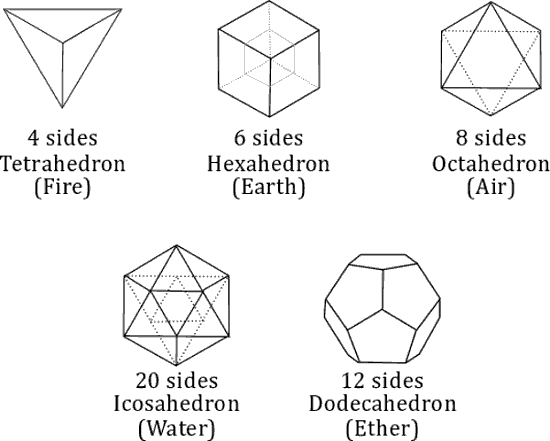
Platonic Solids are sacred geometric shapes originally identified by Plato and are considered the foundational structures of the universe. Each of the five Platonic Solids corresponds to one of the five elements. They are as follows:
- The tetrahedron, with its 4 triangular faces, is associated with the element of fire.
- The hexahedron (or cube), having 6 square faces, represents the element of earth.
- The octahedron has 8 triangular faces and is linked to the element of air.
- The dodecahedron, composed of 12 pentagonal faces, corresponds to the element of ether (or spirit).
- The icosahedron has 20 triangular faces and is connected to the element of water.
The platonic solids have three unique characteristics as follows:
- They have equal edge lengths and identical face shapes and sizes.
- All the vertices look exactly the same.
- All vertices of these shapes can fit precisely within a sphere.
These are the only forms that meet these specific criteria, making these solids the ultimate symbols of strength, balance, and harmony.
Platonic solids also frequently appear in nature. For example, certain crystals like pyrite naturally form into cubes. Similarly, the carbon atoms in diamonds arrange themselves in tetrahedral patterns, while boron’s molecular structure resembles the structure of an icosahedron. Other structures, such as pollen, microorganisms, fractals, sound waves, snowflakes, and even cellular formations, also mimic the geometry of Platonic solids.
11. Merkabah
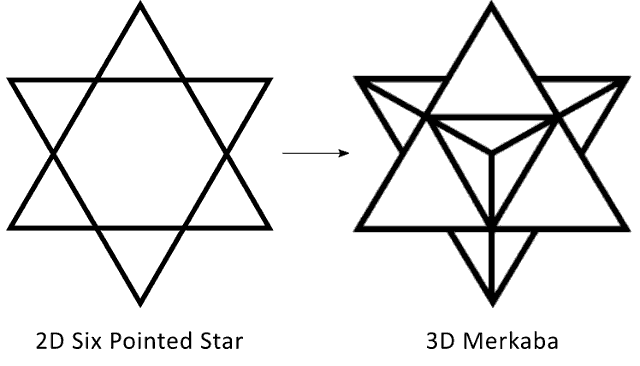
and Merkabah (Star Tetrahedorn)
Merkabah is the 3D representation of the 6 pointed star. It is a star shape formed by the fusion of two tetrahedrons. Hence it is also known as the Star Tetrahedron. The upper tetrahedron represents the element of fire, masculine energy and the spirit world, whereas the lower tetrahedron represents water, feminine energy and the material world. Their fusion represents the essence of all creation.
Merkabah” is a Hebrew term that translates to “Chariot.” The word can be phonetically divided into three parts: “Mer,” meaning Light, “Ka,” signifying Spirit, and “Bah,” denoting Body. Thus the Merkahab symbolizes the union of Spirit (spiritual realm) and Body (material realm) that creates Life or Light.
Some even consider the symbol to have the power to transport your spirit and mind to higher realms when you meditate on it.
Polygons and Polygrams
A polygon is a flat shape with straight sides that are connected end-to-end. Examples include the triangle (3 sides), square (4 sides), pentagon (5 sides), hexagon (6 sides), and so on.
Interestingly, by connecting the non-adjacent vertices (every other corner) of a polygon you can form star-shaped figures known as polygrams. For example, by connecting non-adjacent sides of a hexagon, you get a hexagram or a 6-pointed star. Many of these stars are powerful sacred geometry symbols. Let’s take a look at a few of them.
12. Equilateral Triangle
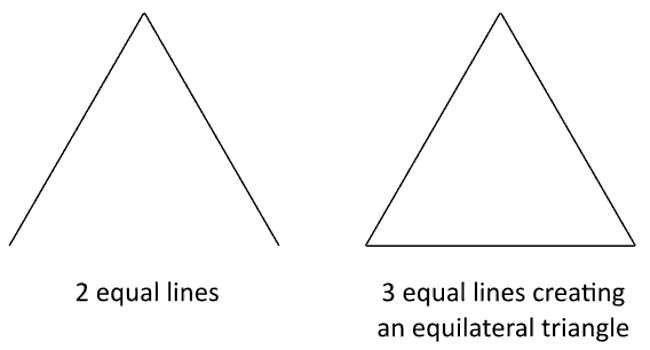
The equilateral triangle is the most basic polygonal shape. It has three sides connected end-to-end. All shapes are of the same length. Just like the Triquetra (that we saw earlier), the equilateral triangle represents the concept of trinity or important universal phenomena that happen in sets of three. For instance, the cyclic process of creation, sustenance, and destruction to create the new.
13. Hexagon & the Hexagram (Six-Pointed Star)
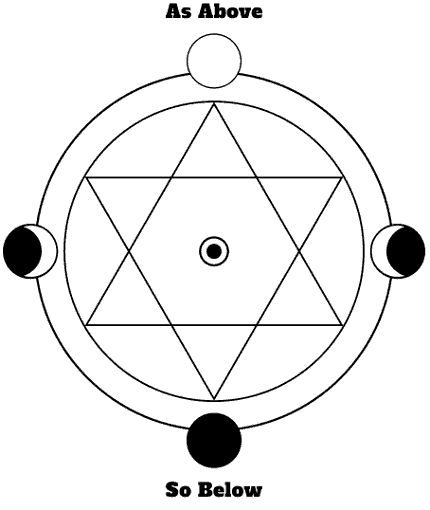
The hexagram or Six-Pointed Star consists of two equilateral triangles, one facing upward and the other facing downward. The upward facing triangle symbolizes the Divine Masculine and the downward facing triangle denotes the Divine Feminine. The triangles merge such that their centers are the same. The hexagram created by their merging symbolizes creation and the central point symbolizes the source of all creation. The hexagram thus symbolizes union, interconnectedness, balance, divine harmony, creation, and creative energy.
The Six pointed star can be drawn by connecting every other vertex in a hexagram to form both triangles as shown in the image below.
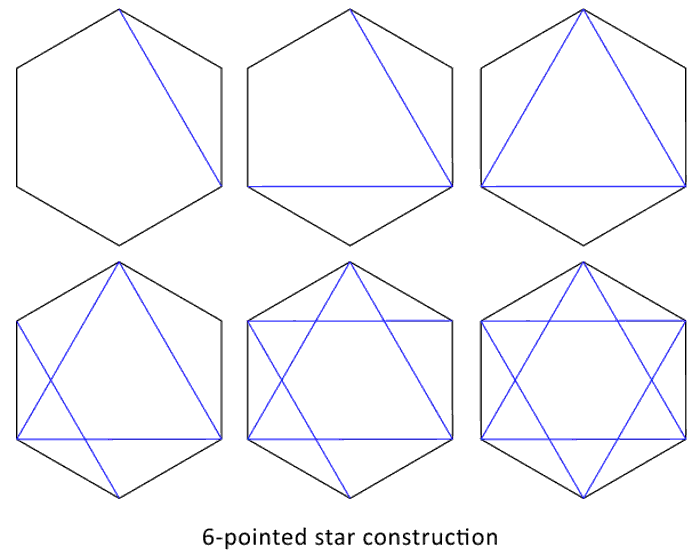
The 3d version of this star is known as the Merkahab as we discussed earlier.
14. Unicursal Hexagram (Unicursal Six-Pointed Star)
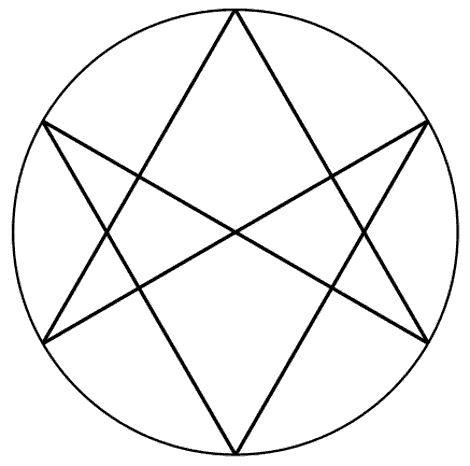
The unicursal hexagram is a six-pointed star that can be drawn in one continuous movement without lifting the pen off the paper (as shown in the image below). This is unlike the regular hexagram (we saw above) that consists of two overlaid triangles and hence cannot be drawn in a single stroke.
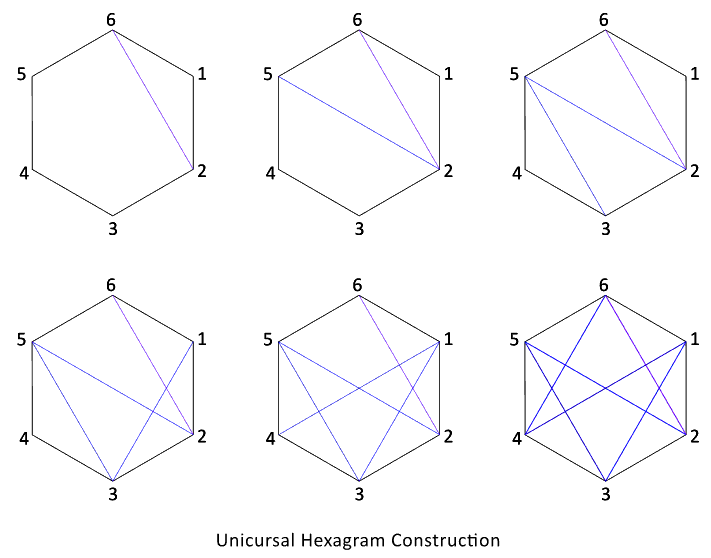
The unicursal hexagram symbolizes infinity, eternal life, magic, oneness, interconnection, and spiritual ascension.
15. Octagon & the Octagram (Eight-Pointed Star)
There are two types of 8-pointed stars that can be drawn using the octagon. The first, known as the 8/2 star, consists of two overlapping squares and is created by connecting every second vertex in the octagon as shown in the image below.
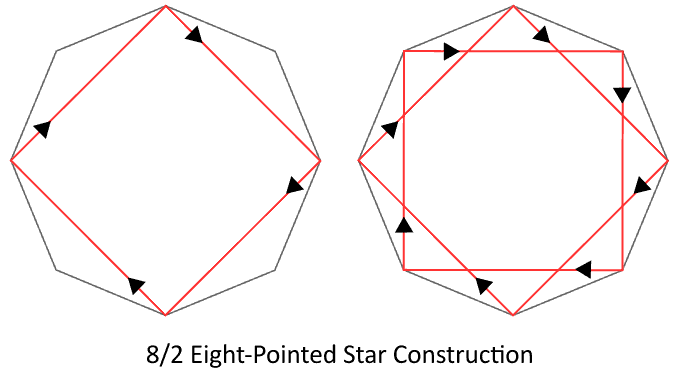
The second, often called the unicursal 8-pointed star (as it can be drawn in a single stroke) or the 8/3 star, is formed by connecting every third vertex in the octagon as shown in the image below..
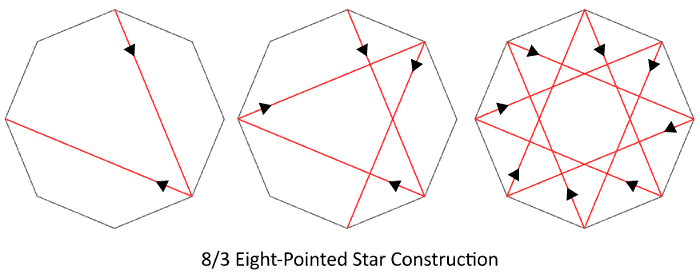
When combined, these stars form what is known as the Octagon Matrix.
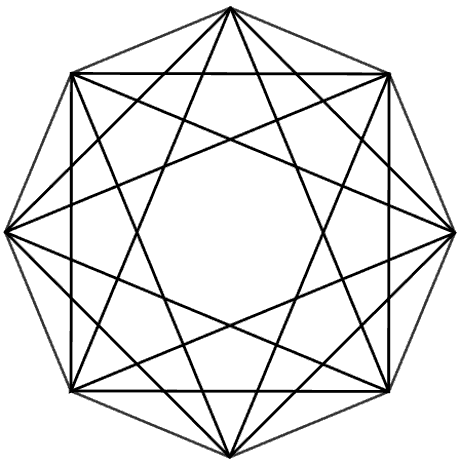
Since ancient times, the 8-pointed star was used as a solar symbol representing the eight major solar events throughout the year: the four seasons—Spring, Summer, Autumn, and Winter—as well as the two equinoxes and two solstices.
Additionally, the 8-pointed star represents concepts of balance and creation.
16. Nonagon & the Nonagram (Nine-Pointed Star)
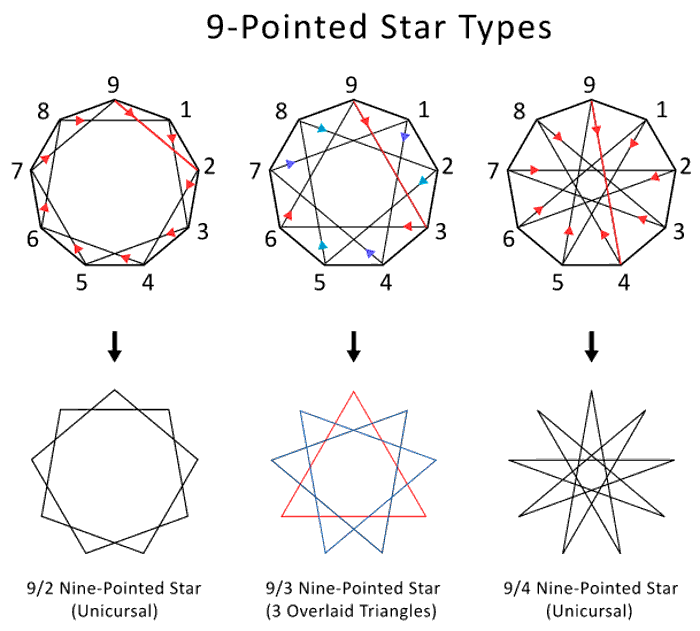
The Nine Pointed Star or the nonagram is a powerful sacred geometry symbol that can be drawn in 3 different ways as follows:
- 9/2 star: This star is drawn by connecting every other 2nd point or vertex in a nonagon. It is unicursal and be drawn in one continuous line.
- 9/3 star: This star has of three overlaid equilateral triangles and is drawn by connecting every 3rd vertex in a nonagram.
- 9/4 star: This star is drawn by connecting every fourth point in a nonagon. This is also a unicursal star.
Each variation of the 9-pointed star has its own unique significance. However, generally speaking, the 9-pointed star symbolizes completeness, spiritual enlightenment, unity, oneness, interconnection, creation, omnipresence, source energy, and divine symmetry.
The image below illustrates all three stars combined known as the Nonagon Matrix.
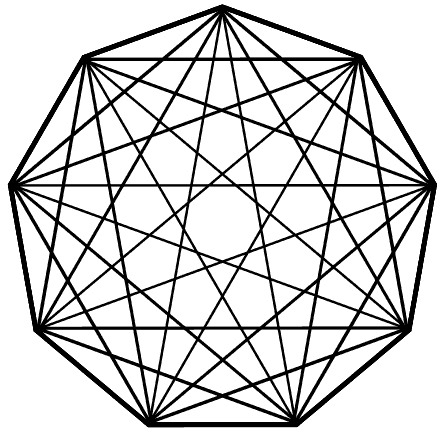
Just like this, various star symbols can be drawn like the 4-pointed, 5-pointed, 6-pointed, 7-pointed, 8-pointed star and so on. Here’s our article discussing all of these different types of star symbols and their symbolism.
17. Square
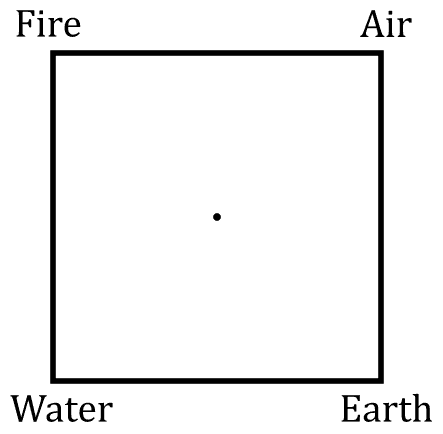
Just like the circle represents the divine feminine, spirit and the spiritual realm, the square represents the divine masculine, matter, and the material realm.
The four corners of the square represent the four elements – Fire, Water, Earth, and Air that make up the material world. Similarly, the four corners also represent the four directions and the four seasons. The square also has a fixed, rigid structure unlike the circle and hence represents the divine masculine.
18. Squared Circle
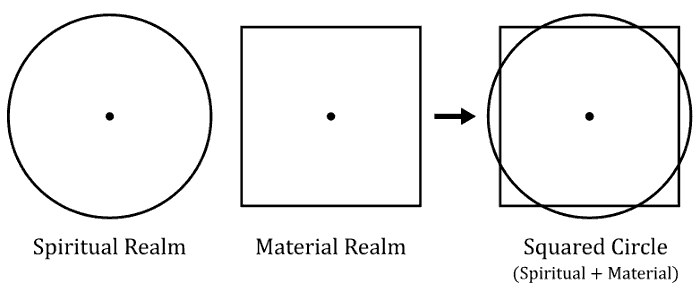
The Squared Circle is a sacred geometry symbol that depicts a circle inside a square. Both the square and the circle share the same center and have the same surface area.
Just like the six-pointed star, this is also a powerful symbol of creation and the universe. This is because the square represents the material realm, whereas the circle represents the spiritual realm. And the universe is essentially the union of the material with the spiritual.
There are many sacred geometry symbols that have been created using the Squared Circle. Some of the most popular ones are the Philosopher’s Stone, Five Fold Knot, and the Witch’s Knot.
19. Philosopher’s Stone
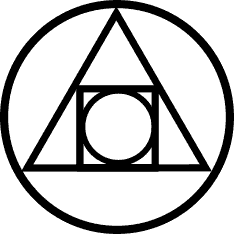
The Philosopher’s Stone is an ancient symbol used by alchemists for the purpose of manifestation, meditation, and reaching higher consciousness. At the core the symbol consists of a squared circle encapsulated by a triangle followed by an outer circle.
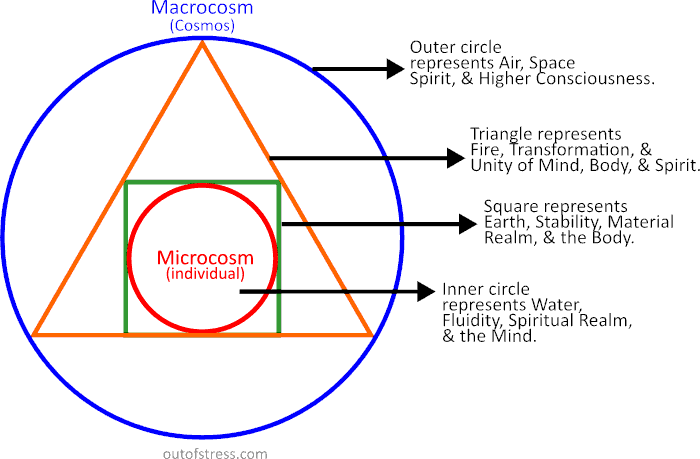
The squared circle at the core represents the universe and the concept of duality. The triangle that follows represents the energetic connection between the spiritual and material worlds. The three sides of the triangle also represent the concept of balance, stability, shape, structure, and form. This is because, you cannot produce any concrete shape using 2 lines, but once you add a third line, you get an enclosed shape in the form of a triangle. Similarly, it also represents the completed human that happens with the union of – Mind, Body, and Spirit.
The outer circle represents the macrocosm as opposed to the inner circle that represents the microcosm. It also represents the cyclic nature of the universe as well as the universal god or consciousness.
The shapes also represent the four elements as depicted in the image above.
20. Tetractys
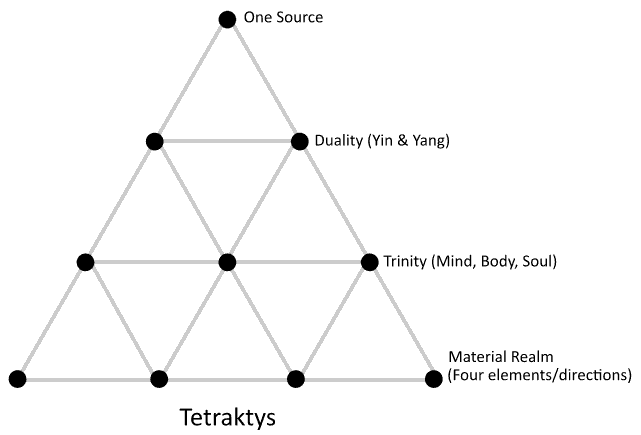
The Tetractys is a Pythagorean symbol that represents the universe and how it functions. The symbol consists of 10 dots arranged like a triangle. The single dot at the top represents the one god, source, or consciousness. It also represents oneness. The two dots that follow represent the one god diving into two (divine masculine & feminine) to create the universe. Thus the two dots also represent the concept of duality.
The three dots that follow represent the world of form, as in order to create an enclosed shape, you need at-least 3 lines. The three dots also represent life that is composed of Mind, Body, and Spirit.
Finally the four dots at the base represent the four elements – Fire, Water, Earth, and Air that make up the material universe. Thus it suggests that the trinity is present within all four elements. The four dots also represent the four cardinal directions and the four seasons.
21. Vector Equilibrium (Cuboctahedron)
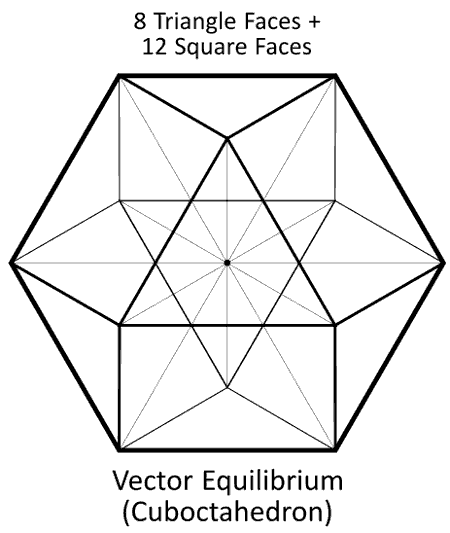
The Cuboctahedron, also known as the Vector Equilibrium, is a sacred geometric form made up of 8 triangular and 6 square faces. It features 12 identical vertices, where two triangles and two squares coverage. The shape also has 24 equal-length edges, each separating a triangle from a square.
The Vector Equilibrium is considered one of the most balanced 3D forms as each one of its points is equidistant from the center. This makes it the only form where all forces are balanced and equal.
Interestingly, by folding along its square edges, the Cuboctahedron can be transformed into other balanced and symmetrical shapes like the icosahedron, octahedron, and tetrahedron (which are platonic solids). This makes the Vector Equilibrium a potent symbol of balance, unity, and harmony.
22. Yin Yang
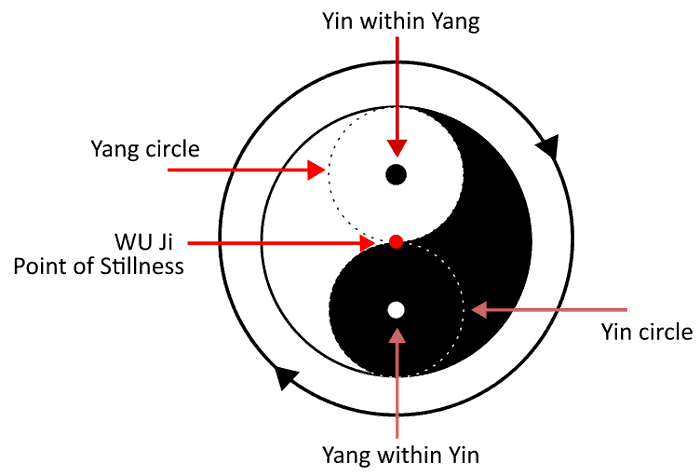
No article on sacred geometry can be complete without the mention of the Yin Yang symbol. This is one of the most powerful symbols that contains within it all the secrets of the universe. It primarily represents the concept of creation that happens by the interaction between the divine masculine (represented by the black section) and the divine feminine (represented by white).
What’s unique about this symbol is that it also shows a seed of white within the black section and black within the white section. This represents that at the very core, masculine resides within the feminine and feminine resides within the masculine. Hence both these forces even though stark opposites are in fact deeply interconnected.
The symbol also depicts the cyclic nature of the universe and how the Yin becomes the Yang and vice versa. To know more about this symbol in depth and how it is created, you can check out our article on the secrets of the Yin Yang.
23. Yantras
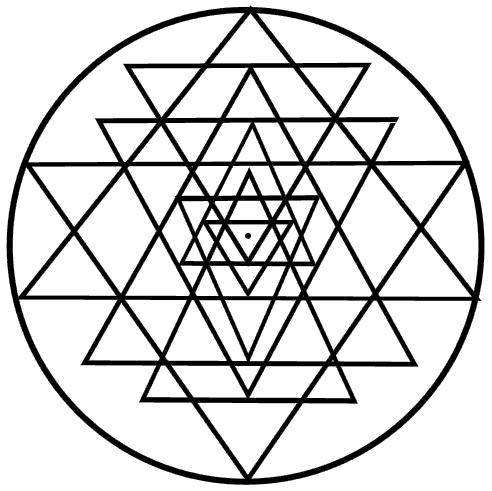
Yantras (visual mantras), are powerful geometric designs in Hinduism that have been used since ages for meditation, attracting positive energies, manifestation, protection, and attaining higher spiritual states. Generally, there are 56 recognized Yantras, each with its unique miraculous advantages.
The most powerful of all yantras is the Sri-Yantra depicted in the image above. It represents creation, manifestation, health, and higher consciousness. Given below are images of some more popular yantras.
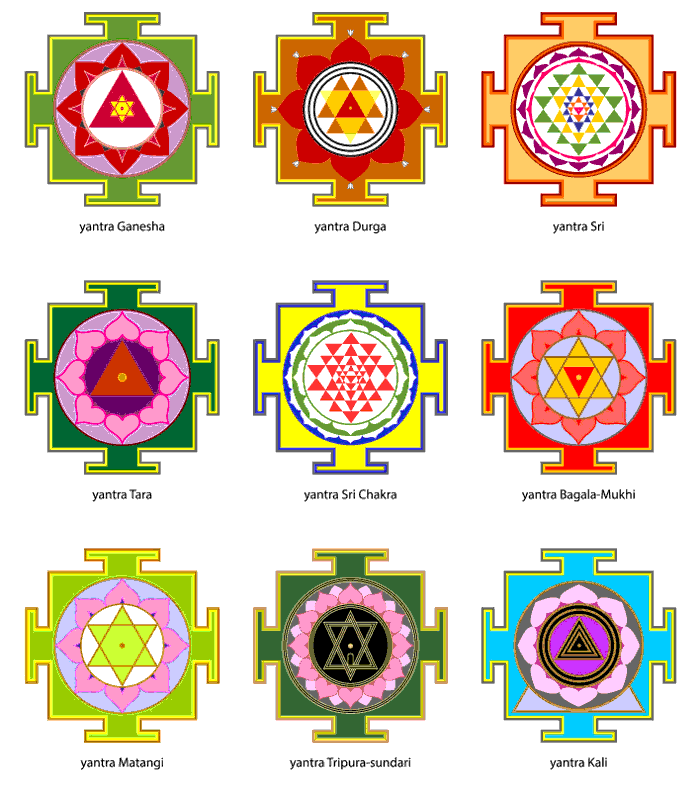
Here’s a list of some important Yantras and their symbolic meanings:
- Sri Yantra: For learning, wisdom, creativity, finance, beauty, and spiritual enrichment.
- Kanakdhara Yantra: For attracting gold and wealth.
- Durga Yantra: For power, strength, and protection against enemies.
- Kuber Yantra: For financial prosperity and wealth accumulation.
- Mahamrityunjaya Yantra: For health and protection against untimely death.
- Ganesha Yantra: For removing obstacles and bringing success in endeavors.
- Lakshmi Yantra: For prosperity, success, and good fortune.
- Navagraha Yantra: For pacifying the nine planets and gaining their positive influences.
The concept of yantras is very deep and we will be discussing that in another article.
Conclusion
In summary, sacred geometry symbols are more than just intricate designs; they are keys to understanding the universe and everything in it. Studying or meditating on these symbols can help raise your consciousness, and bring more healing, alignment, and balance into your life. They can also help clear negative subconscious beliefs and deepen your connection to the divine.
Each symbol described here holds deeper meanings that unfold the more you study them. To get the most out of sacred geometry, consider recreating these symbols yourself, either on paper using geometric tools (like a ruler, and compass) or digitally via computer software. Numerous geometry-focused software programs make it easy to create these complex figures, one example being GeoGebra.


